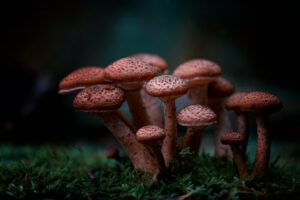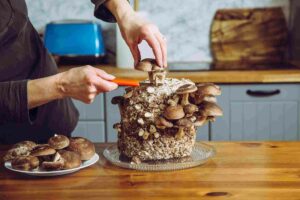The sudden popularity of growing magic mushrooms at home can be attributed to a complex interaction of factors, including legal changes, increased information availability, psychedelic acceptance, and a desire for self-sufficiency and alternative therapy. In particular, cultivating magic mushrooms at home has been more popular since the late 1990s. In this comprehensive analysis, we will examine these factors to comprehend the present magic mushroom farming boom.
The changing legal landscape of psychedelics is one of the main reasons homegrown magic mushrooms are gaining popularity. Over the past several years, public opinion and government policy on these medications have changed.
Growing enchanted mushrooms in the lab
How magic mushrooms are cultivated magic mushrooms, commonly known as psilocybin mushrooms, may be fascinating and rewarding to grow. This is a shortened version of a more complete instruction, and you must perform extensive research and follow all area laws before starting this project.

- Strain Selection
Choose a cultivable magic mushroom strain to begin. It is vital to select a strain that matches your interests and level of knowledge since strains might have varied growth and potency demands.
- Spore Acquisition
The initial phase in mushroom production is spores, the fungus’s small reproductive units. Spore syringes and printouts are available from trusted suppliers and manufacturers.
- For substrate preparation
Substrate is the medium for mushroom development. Typical substrates include brown rice flour, vermiculite, straw, and coffee grounds. Mix the substrate ingredients with water to get a moist, non-gloppy mixture. Use pressure cooking or another method to sterilize this mixture and eradicate competing bacteria.
- Immunization
Inoculation involves adding spores to a prepared substrate. To do this, inject the spore solution into the substrate using a sterile syringe. Working in a clean environment reduces the risk of contamination.
- Time of incubation
After inoculation, substrate containers should be stored in a warm, dark spot, usually between 75 and 80 degrees Fahrenheit (24 and 27 degrees Celsius). This allows mycelium, the white thread-like structure, to colonize the substrate.
- Casing Layer
Some growers add a casing layer to the colonized substrate. This layer, usually peat moss and vermiculite, retains moisture and provides a mushroom-friendly environment.
- Harvesting
Magic mushrooms start as pinhead-sized structures and grow into whole mushrooms over several days. Collect them after the caps open but before the spores emerge. Use clean, sharp scissors or a knife to cut mushrooms at the stem base.
- Dehydration
After harvest, mushrooms must be adequately dried to maintain their vitality. You may dry and crisp them in a food dehydrator, desiccant, or well-ventilated area. Keep dried mushrooms in a sealed container in a dark, cool place.
Growing magic mushrooms requires strict cleanliness and sanitation to prevent illness and losing your crop. Since magic mushroom cultivation is illegal in many regions, you must constantly research and follow local laws.
How much time is required for the cultivation process?
How much time does cultivation take the time needed to develop magic mushrooms depends on the strain, their environment, and the growing method you choose. The process typically takes weeks to months, but it frequently takes longer. The steps and their durations are shown below:

- Inoculation and Colonisation (Two to Four Weeks)
The mushroom’s vegetative tissue, mycelium, will take time to colonize your substrate when the spores or mycelium are introduced. This technique usually takes two to four weeks, although temperature and strain might affect this.
- Optional consolidation (1-2 weeks)
Some growers allow mycelium to colonize the substrate for a long time to consolidate. This approach may improve mushroom production and the mycelium network. One to two weeks may be required for consolidation.
- Fruiting begins (1-2 weeks)
After the mycelium colonizes the substrate, the environmental conditions must change to start fruiting. The mycelium requires fresh air, a lower temperature, and more humidity to achieve this. This first phase usually lasts one to two weeks.
- Fruiting (1-2 Weeks A Go)
After the initiation process, magic mushrooms will form as pins and grow into fully mature mushrooms over one to two weeks. Strain and environmental factors may affect length.
- Continuously collecting over many days
When mature, mushrooms may be picked alone or in groups over many days. Harvesting should begin when the caps are fully open but before they release spores. This may take days to ensure you choose only fully mature mushrooms.
- Drying (1–5 days)
After harvest, mushrooms must be adequately dried to maintain their vitality. This step may take one to five days, depending on the drying method (food dehydrator, desiccant, air drying).
- Rest Period (Optional, 1-2 Weeks)
Some growers believe that allowing the mycelium to recover after harvesting enhances the chance of a second flush or harvest. If taken, this rest break may add one to two weeks to the plan.
- Second Flush (1-2 weeks, if successful)
If the mycelium is healthy, you may notice another flush of mushrooms beyond the stipulated period. This may add one to two weeks to the overall time needed.
- Total Cultivation Time
Starting with substrate preparation and finishing with second flush harvest (if necessary), the cultivation process may take two to four months. However, this is just an approximate estimate, and the real duration may vary based on the strain, ambient circumstances, and cultivator competence.
Also Read : Understanding the Life Cycle of Magic Mushrooms: A Comprehensive Guide
Why Canadians are cultivating mushrooms at home needs explanation
Many persuasive considerations have made growing magic mushrooms at home in Canada appealing. Changing plant laws, increased availability of growing kits and expertise, a desire for self-sufficiency, and an interest in alternative remedies have all contributed to this transition. We’ll discuss reasons why people in Canada have started growing mushrooms in their home cultivation kits.
- Constitutional Status:
In August 2020, Canada legalized magic mushroom psilocybin for end-of-life care, a huge step towards drug reform. While slight, this policy modification showed a more lenient posture towards psychedelics.
It is still illegal to grow magic mushrooms in Canada, but a legislative change has allowed some individuals to grow their own without fear of prosecution.
- Cultivation Kits Are Accessible
Growing magic mushrooms using kits has made the process easier for Canadians. These kits usually include spores or mycelium, substrate, and containers to start growing.
Online retailers and specialty businesses have made these beginning kits available to Canadians. These companies discreetly deliver their items to customers’ houses.
- Online Communities and Information
The internet has helped spread magic mushroom cultivation knowledge. Online forums, social media groups, and specialty websites have created enthusiast communities that share information and experiences.
Online guides and tutorials provide novice growers with step-by-step instructions. The quantity of information has streamlined the process, making it easier for beginners.
- The desire to succeed alone:
Many Canadians grow magic mushrooms at home to fulfill their craving for autonomy and control. One may control product quality and reduce dependency on unreliable vendors by growing their own mushrooms.
Home agriculture supports self-sufficiency and sustainability, which are becoming increasingly valued in society. Individuals may grow mushrooms organically and sustainably.
Could we consume them safely?
The usage of magic mushrooms these safe to consume, which contain the hallucinogenic compound psilocybin, is multifaceted and depends on the person, dosage, preparation, and surroundings. Consider these considerations before using magic mushrooms:
- Serving size
Dosage is the most essential factor in determining magic mushroom safety. Different individuals will have different psilocybin effects, and the amount consumed may affect how strong they are. To avoid overwhelming symptoms, start therapy with a low dose and gradually increase it.
- Stage and Scene
Both the user’s mental state, or “set,” and their physical and social environment, or “setting,” affect whether psychedelics are dangerous or valuable. Relaxing, safe, and supportive environments may reduce anxiety and adverse reactions.
- Mental health:
Psychedelic users with a history of mental illness, especially severe conditions like schizophrenia or bipolar disorder, may have negative effects. Before using magic mushrooms, see a doctor if you have a history of mental health issues.
- Allergic responses and hypersensitivities:
Mushroom allergies are rare but possible. Magic mushrooms should be avoided if you have a fungal or mushroom allergy.
- Legal Considerations
Where you reside affects the legality of magical mushrooms. Owning and using these objects may be illegal in certain places, resulting in legal issues. Knowing and following local regulations is essential to safety.
- Elements Protection
However, magic mushrooms may cause stomach discomfort and nausea at regular doses. Avoiding risky behaviors is crucial to one’s physical health throughout the experience.
- Integration
Integration, or reflecting on and making sense of a psychedelic experience, is crucial for long-term mental health. A psychedelic integration therapist or counselor may be helpful.
Wrapping Up!
Changing legal views, improved availability of knowledge and growing kits, a desire for self-sufficiency, and the discovery of alternative remedies have raised interest in home-grown magic mushrooms. These characteristics have made home production popular, but prudent and safe practices are crucial.
Magic mushroom rules vary by area. Therefore, people must follow them. Working with psychedelics requires sterilization, dose control, and consideration of mental health and the environment.

Hi! I’m Jacob Hawthorne, a passionate medical student dedicated to exploring the fascinating world of psychedelics, particularly magic mushrooms (commonly known as shrooms). With a deep interest in their therapeutic potential and profound effects on the human mind, I aim to provide accurate and evidence-based information about shrooms in the Canadian context.

